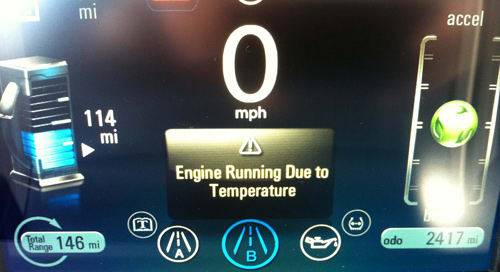Chevy Volt: Why's The Engine Running?


I left home with 15 miles of range, met little traffic and arrived 17 miles later with 5 miles of electric range to spare. I think this has more to do with time than miles. More time equals more electricity used to keep myself warm. The distance was the same, and experience suggests the Volt is roughly as efficient at low speeds as it is at high.
During that first journey, I was on the road for only a couple of blocks when I was surprised by the gas engine turning on, accompanied by a notice on the instrument panel that read, “Engine running due to temperature.” This happens strictly to provide cabin heat, according to Chevrolet. The electric heater isn’t always powerful enough to warm the cabin by itself in subfreezing temperatures, and if it were, it would drain too much battery power. The design is a delicate balance that attempts to be efficient in the long run.
Internal combustion engines are only about 20%efficient, so one could argue they’re actually better at producing heat than anything else. It’s not just wasted idling, though: The engine drives the generator and stores some electricity in the battery pack. The engine was on for only a minute, maybe two, at the beginning of that journey of over an hour, and apparently that was enough for my circumstance. Outside temperature, speed, wind and sunlight affect interior heat.
I could reconcile this behavior because I recognize the goal is long-range efficiency and because a negligible amount of gasoline was used. But I know people tend to fixate on electric-only operation — in this and in conventional hybrids — regardless of the bottom line. There will definitely be objections.
Although I understand the principle, I didn’t expect it to happen when the car had been plugged in, which allows the Volt to keep its battery in a target temperature range, and I definitely didn’t expect it when the car still is plugged in.
One of the car’s attractions to me was its ability to pre-condition (heat or cool) the cabin via remote start, using the key fob or through OnStar using myvolt.com or an iPhone app. I had assumed this would be 100 percent electrical, but at least once when I tried it, the engine started. I have an unheated attached garage, and I thought the Volt would be my chance to use remote start without leaving the car out in the snow, but apparently it’s not meant to be.
Senior editor David Thomas attempted the same type of remote start on a 20 degree morning and the engine did not kick on. When he got in the car 10 minutes later it was warm in the cabin and the motor was the lone powerplant until he had driven about a mile in the frigid temps. He also has a detached garage and had the door open during the warm-up.
Perhaps Chevy can program the car not to start the engine in situations like this at all times. Given enough time in a wind-free garage, the onboard electric heater would raise the temperature substantially, even if it didn’t hit a target temperature. Without a provision like this, it’s not worth the risk of firing up the gas engine in my attached garage.

Former Executive Editor Joe Wiesenfelder, a Cars.com launch veteran, led the car evaluation effort. He owns a 1984 Mercedes 300D and a 2002 Mazda Miata SE.
Featured stories


2026 Aston Martin DBX S Review: Excellence in (DB)X S


